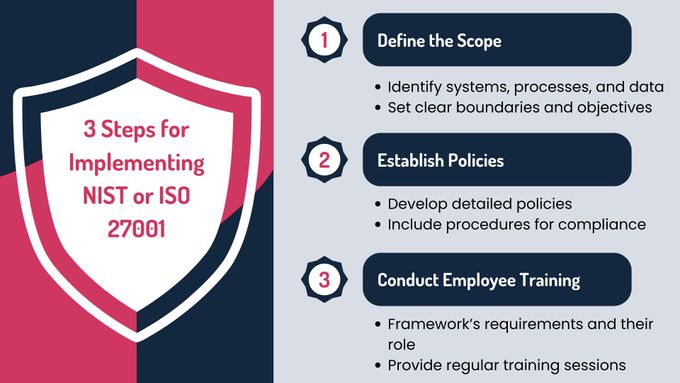NIST vs ISO 27001: How to Choose the Right Framework for Your Business
Finding the right cybersecurity framework for your organization starts with understanding their key differences and similarities.
Published April 5, 2025.

Cybersecurity is a critical element of your business strategy, affecting every aspect of your operations. With increasing cyber threats, adopting robust security measures is essential.
Frameworks like NIST (National Institute of Standards and Technology) and ISO 27001 offer structured approaches to protect sensitive data and ensure regulatory compliance.
» Not sure whether to choose NIST or ISO 27001? Let our experts help
Overview of NIST and ISO 27001
NIST Framework
The NIST framework, particularly the NIST Cybersecurity Framework (CSF), is a voluntary framework developed by the US government to help you manage cybersecurity risks. It offers a flexible, high-level set of guidelines that you can customize to your specific needs.
NIST is often favored by organizations in the early stages of developing their cybersecurity programs or those working with US federal agencies. It’s built around five core functions that provide a comprehensive approach to managing cybersecurity risks:
- Identify
- Protect
- Detect
- Respond
- Recover
ISO 27001
ISO 27001 is an international standard for information security management systems (ISMS). It provides a systematic approach to managing sensitive company information and ensuring its security.
ISO 27001 requires organizations to undergo a formal certification process, which includes a third-party audit. This certification is globally recognized and can be a significant asset for businesses, particularly those operating internationally or in regulated industries like finance and healthcare.
The ISO 27001 framework emphasizes continuous improvement, requiring organizations to regularly assess and update their security measures.
» Learn about achieving ISO 27001 and maintaining it
Global Adoption: NIST vs. ISO 27001
Both NIST and ISO 27001 are widely adopted, though in different contexts. The choice between NIST and ISO 27001 generally depends on your location, industry, and specific regulatory needs.
Key Similarities and Differences Between NIST & ISO 27001
Similarities
- Focus on cybersecurity domains: Both frameworks address protecting sensitive information and managing risks.
- Emphasis on best practices: They promote best practices in security management.
- Control areas covered: Both include similar control areas such as access management, incident response, and risk assessment.
- Objective: Each framework aims to provide tools and guidelines for robust security practices.
Differences
| | NIST | ISO 27001 |
|---|---|---|
| Structure | Flexible and high-level | Structured and rigorous |
| Certification | No formal certification required | Requires formal third-party certification |
| Customization | Allows tailoring of security programs to specific needs | Follows a set framework with core clauses and specific controls |
| Maturity Levels | Categorizes into four tiers: partial, risk-informed, repeatable, and adaptive | Emphasizes continuous improvement through regular audits and updates |
| Approach | Gradual improvements based on maturity levels | Cycle of assessing, improving, and certifying security posture |
NIST is a more flexible, high-level framework that allows you to tailor your security programs to your specific needs without requiring formal certification.
ISO 27001, in contrast, is a more structured and rigorous framework requiring a formal certification process. It emphasizes continuous improvement through regular audits and updates, making it a cycle of assessing, improving, and certifying your security posture. This approach is particularly beneficial if you need a well-defined and consistently monitored security program.
Benefits of ISO 27001 Certification vs. NIST Guidelines
Understanding the benefits and merits of ISO 27001 certification and NIST guidelines is essential for making the right choice for your organization. Here’s a breakdown of the benefits each framework offers:
Benefits of ISO 27001
- International recognition: Achieving ISO 27001 certification will significantly boost your organization's credibility as it's recognized and respected globally, enhancing trust with international clients and partners.
- Regulatory compliance: The framework aligns with stringent regulatory requirements, making it particularly beneficial for industries like finance and healthcare, where adherence to international security standards is mandatory.
- Third-party validation: ISO 27001 offers a formal certification process that provides third-party validation of your security practices, strengthening trust with stakeholders and customers.
» Take your ISO compliance further by learning about ISO 27701
Benefits of NIST Guidelines
- Tailored flexibility: NIST offers a highly flexible approach, allowing organizations to customize their cybersecurity measures to fit specific needs and maturity levels, making it suitable for various sectors.
- Scalable framework: The NIST guidelines are scalable, enabling smaller organizations to start with a basic security framework that can expand as the business grows and its needs evolve.
- Accessible implementation: NIST's framework is relatively easy to implement, providing a practical starting point for organizations that are in the early stages of developing their cybersecurity strategies.
Choosing the Right Framework: Key Factors
When deciding between NIST and ISO 27001, consider the following factors:
- Regulatory requirements: Are there industry-specific regulations that mandate or favor one framework over the other? ISO 27001 is best for highly regulated industries needing formal certification, while NIST suits industries with more flexibility and no certification requirements.
- Resources: Do you have the resources to maintain a formal certification process? ISO 27001's structured approach requires significant resources, whereas NIST is more practical and scalable for organizations with limited resources.
- Geographic focus: Are you primarily operating within the US or internationally? ISO 27001's international recognition is advantageous for global businesses, while NIST aligns better with US-based operations, especially those involving federal agencies.
- Business goals: What are your long-term security goals? ISO 27001 is ideal for those seeking a mature, internationally recognized security posture, while NIST offers flexibility for organizations focused on gradual security improvement.
Scenario Analysis: Which Framework Suits Your Business?
- NIST: May be more suitable for US-based organizations, particularly those interacting with federal agencies or those that are in the early stages of developing their security programs. It is also ideal for organizations that need a flexible, scalable framework that can grow with them over time.
- ISO 27001: Better suited for organizations that require a formal certification to demonstrate their commitment to security, particularly those in highly regulated industries like finance, healthcare, and technology. It is also ideal for businesses operating internationally, where global recognition of the certification is a significant advantage.
» Operating a startup? Here are some cyber tips to beef up your security
Implementing NIST or ISO 27001: Best Practices
Implementing NIST or ISO 27001
Define the Scope of Your Cybersecurity Framework
Identify which systems, processes, and data require protection. Clear boundaries and objectives ensure comprehensive coverage and alignment with your security needs.
Establish Comprehensive Policies
Policies should match the chosen framework. These policies should include detailed guidelines and procedures to ensure compliance with framework requirements.
Employee Training
Everyone, from leadership to operational staff, must understand the framework’s requirements and their role in maintaining compliance. Regular training sessions and updates are necessary to keep everyone informed and committed to security standards.
» Still confused? Here's everything you need to know about ISO 27001
Dual-Framework Approach: Is It Feasible?
In some cases, organizations may benefit from implementing both NIST and ISO 27001 frameworks simultaneously. This dual-framework approach can provide comprehensive coverage, leveraging NIST's flexibility while benefiting from ISO 27001's formal certification.
However, this approach requires careful planning and resource allocation to avoid duplication of effort and ensure that both frameworks are effectively integrated.
Consequences of Choosing the Wrong Framework
Choosing a framework that does not align with an organization’s specific needs can lead to several significant challenges, including:
- Inadequate security measures: A framework that is too lenient or not tailored to your organization’s unique risks may leave the company vulnerable to a range of cyber threats, increasing the likelihood of security breaches.
- Regulatory non-compliance: Failure to adhere to industry-specific regulations and standards can result in severe legal penalties, fines, and damage to your organization's reputation, eroding customer trust and market position.
- Wasted resources: Implementing a framework that doesn't align with your business goals or operational requirements can lead to unnecessary expenses, wasted effort, and the misallocation of valuable resources, ultimately hindering overall business efficiency.
How GRSee Supports Framework Selection and Implementation
Selecting the right cybersecurity framework is important for establishing a solid security posture. Whether you’re considering the global recognition of becoming ISO 27001 compliant or the flexibility of NIST, it’s vital to select a framework that aligns with your business needs and regulatory requirements.
GRSee’s expert team assists you in choosing a framework that meets industry standards and aligns with your operational goals.
We offer comprehensive services:
- Advisory services: We guide you through the decision-making process, helping you choose the most appropriate framework that best fits your organization's needs and regulatory landscape.
- Implementation support: We assist in the seamless integration of the chosen framework into your business operations, ensuring that it is fully aligned with your objectives and compliant with all relevant regulations.
- Ongoing support: Our commitment doesn't end just with implementation—we also provide continuous compliance monitoring, auditing, and improvement services to adapt to evolving threats and strengthen your overall security posture over time.
Partnering with GRSee helps you navigate cybersecurity complexities, ensuring robust and compliant defenses and positioning your business for sustained success in a rapidly changing digital landscape.







